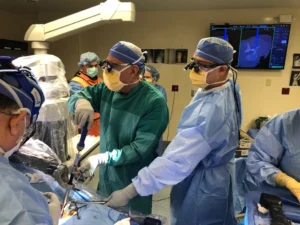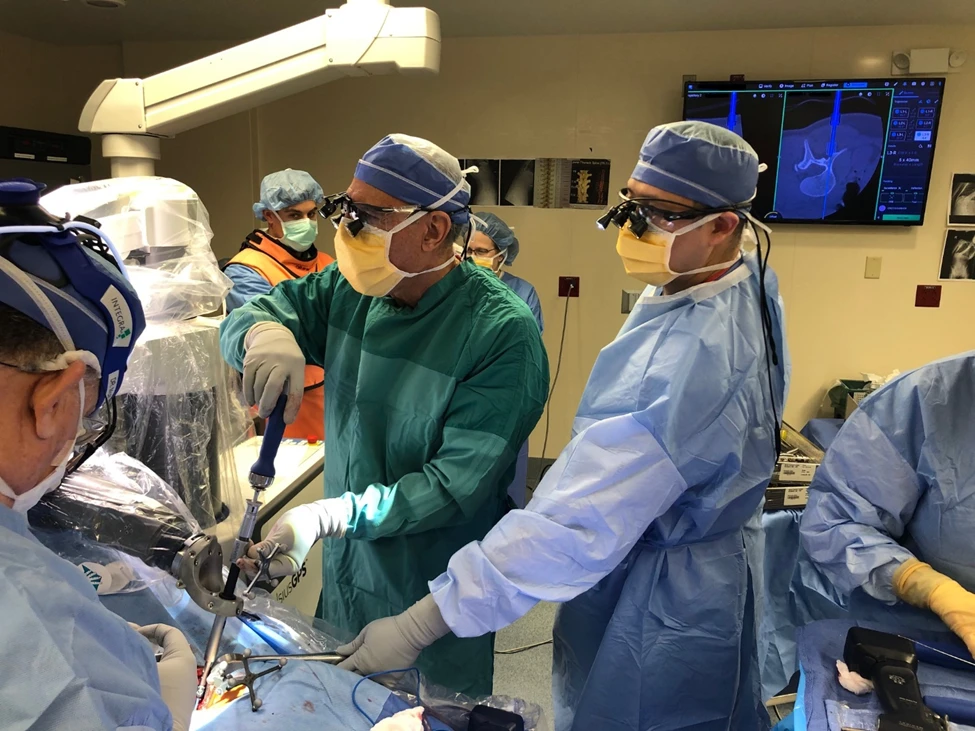Pioneering Robot-Assisted Lateral Lumbar Interbody Fusion (LLIF) with ExcelsiusGPS™

- May 3, 2021
- Posted in Excelsius™ Technology
Lateral lumbar interbody fusion (LLIF) is a type of minimally invasive lumbar interbody fusion surgery in which surgeons access the spine from the side.
Lumbar interbody fusion surgery (LIF) involves removing disc material between two vertebrae and replacing it with an implant. The standard approach to fusion surgery is anteriorly (ALIF) through the abdomen or posteriorly (PLIF) through a large incision in the back.1
Accessing the spine through the patient’s side allows the surgeon to cut through fewer muscles or surrounding tissue during the approach. As such, LLIF may offer the reported advantages of a minimally invasive surgery (MIS), such as low blood loss, shorter length of stay, decreased recovery time, and less postoperative pain due to the smaller incisions and decreased tissue damage.2
Utilizing ExcelsiusGPS™ robotic navigation, surgeons gain the added benefits of robot-assisted LLIF procedures without compromising indirect decompression and disc height. The system enables visualization of integrated interbody instruments and implants, permitting the placement of ideally sized Globus expandable interbody spacers for stabilization and height restoration.
Innovating the LLIF Technique in Baltimore, MD
A team of spine experts at MedStar Orthopaedic Institute became the first facility in the mid-Atlantic region to use ExcelsiusGPS™ to perform minimally invasive LLIF through a tiny incision in the patient’s side.
Veteran surgeons Dr. Paul McAfee and Dr. Paul Asdourian led a 55-year-old female patient through a lumbar fusion to remove two herniated discs, insert an expandable spacer, place posterior fixation, and align the spine. The patient suffered from degenerative disc disease and arthritis in her lower back, and was unable to stand straight without experiencing pain.
The surgeons employed ExcelsiusGPS™ technology to navigate surgical instruments and hardware through a small incision at the waist.3 The robot allowed them to remove the damaged discs, insert expandable spacers to separate vertebrae, and lift pressure off the pinched nerves. Robotic assistance was used to insert screws along the trajectory planned by the surgeons.
“We can be more precise doing the LLIF approach using the robotic navigation,” Dr. McAfee explained in a press release. “If you’re going to put something inside the human body, you have to figure out where to start and what trajectory is needed to get to where you’re going. You spend as much time planning out the surgery as you do performing it […], but you go in knowing exactly which instruments you’re using, the size of the implant, and you’re not doing a lot of improvisation at the time of surgery.”
The surgeon’s use of ExcelsiusGPS™ allowed visualization of the patient’s anatomy throughout the procedure, aiding in a streamlined surgical workflow and reducing X-ray radiation exposure to the team.4
“Having the robot to navigate the placement of instruments so that we knew our implants were in a perfect position made the procedure hugely successful,” added Dr. Asdourian. “Without the robotic navigation, we would have done this from a posterior approach. But to do so, you have to be more aggressive in removing bone, with greater blood loss, and it’s a harder operation for patients to recover from. This case didn’t require a blood transfusion, and the patient is able to stand straight up. The case went perfectly and [the patient’s] doing great.”

1 Meng B, Bunch J, Burton D, Wang J. Lumbar interbody fusion: recent advances in surgical techniques and bone healing strategies. Eur Spine J. 2021 Jan;30(1):22-33. doi: 10.1007/s00586-020-06596-0. Epub 2020 Sep 19. PMID: 32949311.
2 Salzmann SN, Fantini GA, Okano I, Sama AA, Hughes AP, Girardi FP. Mini-open access for lateral lumbar interbody fusion: indications, technique, and outcomes. JBJS Essent Surg Tech. 2019 Nov 1;9(4):e37.1-10. doi: 10.2106/JBJS.ST.19.00013. PMID: 32051785; PMCID: PMC6974316.
3 https://www.mayfieldclinic.com/pe-llif.htm
4 https://www.healthnewsdigest.com/news/Surgery_540/Robot-Proves-Groundbreaking-in-Spinal-Surgery.shtml
